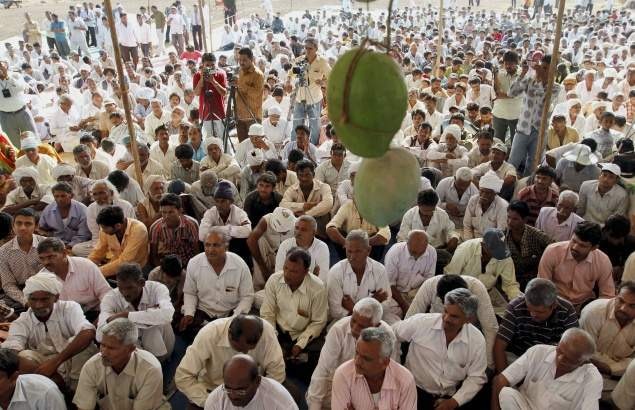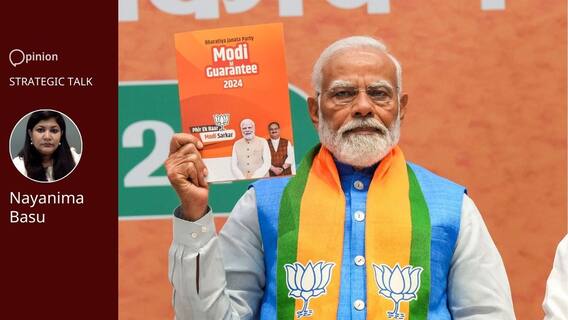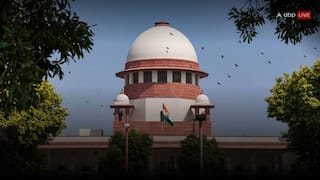Explorer
Advertisement

Crisis looms on farm sector: Loans, costs make farming unviable

The state government will form a committee to decide criteria to waive off loans. Photo: File
India is going through an agriculture crisis. This agriculture crisis, unlike earlier ones, is less about natural hazards, drought and floods, and more about economics. Most of the farms in India, are small or very small. As per the highlights of the agricultural census, 2010-11, 85% of Indian farmers till land smaller than two hectares in size (about 20,000 square metres).
 Farmers are increasingly finding that their input costs – seeds, fertilizers, and transportation, are greater than the money they can earn from farming. Agriculture debt is a very real problem, and it is believed that much of the debt is held by the informing lending sector, moneylenders. As per the NSSO report, 52% of agricultural households in India are in debt, and the average debt was approximately Rs.47,000. In the same period, it was estimated that agricultural families earned approximately 37,000 from cultivation. The bulk of the income, was made up of ‘other sources’ including manual labour.
Since March 2017, farmers are back in the news, and in ways that has given the Government of India, and the respective states, sleepless nights. It began with the UP elections, and the Prime Minister promising to waive the loans of small farmers in the state. Post the BJP’s victory in the state, this was one of the first acts of the new state government led by Chief Minister Adityanath, who waived Rs 36,359 crores of unpaid debt. This has had a domino effect on the rest of the states.
Farmers from Tamil Nadu were already agitating to have their debts waived, and were protesting in Delhi to get heard by the Central Government. Their protest was not really successful, it seemed that the Central Government was too busy campaigning in Uttar Pradesh, to care about the farmers in a state, where they have no hope of winning elections in the foreseeable future. The State Government of TN, aided by the Madras HC’s decree to waive loans, has bought itself time, but it Is not clear how long this would last.
Maharashtra was next, with farmers in the prosperous Western parts of Maharashtra protesting not just for a loan waiver, but a guaranteed higher minimum rate for their produce. There was a seeming moment of agreement between the Government and the protestors, but that has slipped by, with both sides taking more or less entrenched positions.
The next state where there is chaos on the issue of agriculture loans is Madhya Pradesh, where already 5 farmers (some accounts say 6) have died as protests turned violent, and police opened fire. While the Government’s vocal support brigade across media – both traditional and social – is trying hard to justify the killings, the fact remains it is terrible optics for a Government that is not just celebrating its third anniversary, but is already in election mode for the 2019 elections. Shooting dead protesting farmers, in a land that is primarily agrarian, is not just a tragedy, it is a blunder, and the Government will open up the exchequer to make sure that this is forgotten soon. Unfortunately, neither the centre nor the states have surplus funds to pay for this. In states that are already adopting deficit financing to run the place, this is going to be an added burden. Also, once the Pandora’s box of loan waivers is opened up, it is difficult to shut it again. Especially, the way it is being done as electoral advantage, rather than sector efficiency.
The problem is also the concept of a loan waiver, where protestors are saying we won’t pay back because we can’t pay back, and this default by us needs to be excused, and in the future, more loans need to come our way. The second problem is that of minimum price guarantee for farm and diary produce. If the Government capitulates, as it looks likely that it would, then we can expect
The last time there was a loan waiver, was in 2008, where farmers who held less than 2 acres of land, had their loans with the formal banking sector waived. The 2008 loan waiver had it’s own set of issues including the fact that it did not account for debt held by money lenders. However, it’s great advantage, compared to the way the current crisis is being handled, is that it was a one-shot act, across the country.
The current bout of loan waivers has been poorly thought through, if at all it has been thought through. As more and more states give in to the demands of farmers, after a few days of protests, farmers in the remaining states will protest to have their loans waived. The Reserve Bank of India has already cautioned against loan waivers, but since they aren’t fighting elections, they are not going to be heeded. At this point of time it may be simpler for the Central Government to follow the 2008 policy, and have a one-shot loan waiver across the country, rather than let protests erupt.
The moment protestors know they can get financial gain from their protests, it will not stop. The Government must take heed of this, and act in National Interest, and not for electoral gain.
(Harini Calamur is a writer, teacher and film-maker. She tweets at @calamur)
Disclaimer: The opinions, beliefs and views expressed by the various authors and forum participants on this website are personal and do not reflect the opinions, beliefs and views of ABP News Network Pvt Ltd.
Farmers are increasingly finding that their input costs – seeds, fertilizers, and transportation, are greater than the money they can earn from farming. Agriculture debt is a very real problem, and it is believed that much of the debt is held by the informing lending sector, moneylenders. As per the NSSO report, 52% of agricultural households in India are in debt, and the average debt was approximately Rs.47,000. In the same period, it was estimated that agricultural families earned approximately 37,000 from cultivation. The bulk of the income, was made up of ‘other sources’ including manual labour.
Since March 2017, farmers are back in the news, and in ways that has given the Government of India, and the respective states, sleepless nights. It began with the UP elections, and the Prime Minister promising to waive the loans of small farmers in the state. Post the BJP’s victory in the state, this was one of the first acts of the new state government led by Chief Minister Adityanath, who waived Rs 36,359 crores of unpaid debt. This has had a domino effect on the rest of the states.
Farmers from Tamil Nadu were already agitating to have their debts waived, and were protesting in Delhi to get heard by the Central Government. Their protest was not really successful, it seemed that the Central Government was too busy campaigning in Uttar Pradesh, to care about the farmers in a state, where they have no hope of winning elections in the foreseeable future. The State Government of TN, aided by the Madras HC’s decree to waive loans, has bought itself time, but it Is not clear how long this would last.
Maharashtra was next, with farmers in the prosperous Western parts of Maharashtra protesting not just for a loan waiver, but a guaranteed higher minimum rate for their produce. There was a seeming moment of agreement between the Government and the protestors, but that has slipped by, with both sides taking more or less entrenched positions.
The next state where there is chaos on the issue of agriculture loans is Madhya Pradesh, where already 5 farmers (some accounts say 6) have died as protests turned violent, and police opened fire. While the Government’s vocal support brigade across media – both traditional and social – is trying hard to justify the killings, the fact remains it is terrible optics for a Government that is not just celebrating its third anniversary, but is already in election mode for the 2019 elections. Shooting dead protesting farmers, in a land that is primarily agrarian, is not just a tragedy, it is a blunder, and the Government will open up the exchequer to make sure that this is forgotten soon. Unfortunately, neither the centre nor the states have surplus funds to pay for this. In states that are already adopting deficit financing to run the place, this is going to be an added burden. Also, once the Pandora’s box of loan waivers is opened up, it is difficult to shut it again. Especially, the way it is being done as electoral advantage, rather than sector efficiency.
The problem is also the concept of a loan waiver, where protestors are saying we won’t pay back because we can’t pay back, and this default by us needs to be excused, and in the future, more loans need to come our way. The second problem is that of minimum price guarantee for farm and diary produce. If the Government capitulates, as it looks likely that it would, then we can expect
The last time there was a loan waiver, was in 2008, where farmers who held less than 2 acres of land, had their loans with the formal banking sector waived. The 2008 loan waiver had it’s own set of issues including the fact that it did not account for debt held by money lenders. However, it’s great advantage, compared to the way the current crisis is being handled, is that it was a one-shot act, across the country.
The current bout of loan waivers has been poorly thought through, if at all it has been thought through. As more and more states give in to the demands of farmers, after a few days of protests, farmers in the remaining states will protest to have their loans waived. The Reserve Bank of India has already cautioned against loan waivers, but since they aren’t fighting elections, they are not going to be heeded. At this point of time it may be simpler for the Central Government to follow the 2008 policy, and have a one-shot loan waiver across the country, rather than let protests erupt.
The moment protestors know they can get financial gain from their protests, it will not stop. The Government must take heed of this, and act in National Interest, and not for electoral gain.
(Harini Calamur is a writer, teacher and film-maker. She tweets at @calamur)
Disclaimer: The opinions, beliefs and views expressed by the various authors and forum participants on this website are personal and do not reflect the opinions, beliefs and views of ABP News Network Pvt Ltd.
 Farmers are increasingly finding that their input costs – seeds, fertilizers, and transportation, are greater than the money they can earn from farming. Agriculture debt is a very real problem, and it is believed that much of the debt is held by the informing lending sector, moneylenders. As per the NSSO report, 52% of agricultural households in India are in debt, and the average debt was approximately Rs.47,000. In the same period, it was estimated that agricultural families earned approximately 37,000 from cultivation. The bulk of the income, was made up of ‘other sources’ including manual labour.
Since March 2017, farmers are back in the news, and in ways that has given the Government of India, and the respective states, sleepless nights. It began with the UP elections, and the Prime Minister promising to waive the loans of small farmers in the state. Post the BJP’s victory in the state, this was one of the first acts of the new state government led by Chief Minister Adityanath, who waived Rs 36,359 crores of unpaid debt. This has had a domino effect on the rest of the states.
Farmers from Tamil Nadu were already agitating to have their debts waived, and were protesting in Delhi to get heard by the Central Government. Their protest was not really successful, it seemed that the Central Government was too busy campaigning in Uttar Pradesh, to care about the farmers in a state, where they have no hope of winning elections in the foreseeable future. The State Government of TN, aided by the Madras HC’s decree to waive loans, has bought itself time, but it Is not clear how long this would last.
Maharashtra was next, with farmers in the prosperous Western parts of Maharashtra protesting not just for a loan waiver, but a guaranteed higher minimum rate for their produce. There was a seeming moment of agreement between the Government and the protestors, but that has slipped by, with both sides taking more or less entrenched positions.
The next state where there is chaos on the issue of agriculture loans is Madhya Pradesh, where already 5 farmers (some accounts say 6) have died as protests turned violent, and police opened fire. While the Government’s vocal support brigade across media – both traditional and social – is trying hard to justify the killings, the fact remains it is terrible optics for a Government that is not just celebrating its third anniversary, but is already in election mode for the 2019 elections. Shooting dead protesting farmers, in a land that is primarily agrarian, is not just a tragedy, it is a blunder, and the Government will open up the exchequer to make sure that this is forgotten soon. Unfortunately, neither the centre nor the states have surplus funds to pay for this. In states that are already adopting deficit financing to run the place, this is going to be an added burden. Also, once the Pandora’s box of loan waivers is opened up, it is difficult to shut it again. Especially, the way it is being done as electoral advantage, rather than sector efficiency.
The problem is also the concept of a loan waiver, where protestors are saying we won’t pay back because we can’t pay back, and this default by us needs to be excused, and in the future, more loans need to come our way. The second problem is that of minimum price guarantee for farm and diary produce. If the Government capitulates, as it looks likely that it would, then we can expect
The last time there was a loan waiver, was in 2008, where farmers who held less than 2 acres of land, had their loans with the formal banking sector waived. The 2008 loan waiver had it’s own set of issues including the fact that it did not account for debt held by money lenders. However, it’s great advantage, compared to the way the current crisis is being handled, is that it was a one-shot act, across the country.
The current bout of loan waivers has been poorly thought through, if at all it has been thought through. As more and more states give in to the demands of farmers, after a few days of protests, farmers in the remaining states will protest to have their loans waived. The Reserve Bank of India has already cautioned against loan waivers, but since they aren’t fighting elections, they are not going to be heeded. At this point of time it may be simpler for the Central Government to follow the 2008 policy, and have a one-shot loan waiver across the country, rather than let protests erupt.
The moment protestors know they can get financial gain from their protests, it will not stop. The Government must take heed of this, and act in National Interest, and not for electoral gain.
(Harini Calamur is a writer, teacher and film-maker. She tweets at @calamur)
Disclaimer: The opinions, beliefs and views expressed by the various authors and forum participants on this website are personal and do not reflect the opinions, beliefs and views of ABP News Network Pvt Ltd.
Farmers are increasingly finding that their input costs – seeds, fertilizers, and transportation, are greater than the money they can earn from farming. Agriculture debt is a very real problem, and it is believed that much of the debt is held by the informing lending sector, moneylenders. As per the NSSO report, 52% of agricultural households in India are in debt, and the average debt was approximately Rs.47,000. In the same period, it was estimated that agricultural families earned approximately 37,000 from cultivation. The bulk of the income, was made up of ‘other sources’ including manual labour.
Since March 2017, farmers are back in the news, and in ways that has given the Government of India, and the respective states, sleepless nights. It began with the UP elections, and the Prime Minister promising to waive the loans of small farmers in the state. Post the BJP’s victory in the state, this was one of the first acts of the new state government led by Chief Minister Adityanath, who waived Rs 36,359 crores of unpaid debt. This has had a domino effect on the rest of the states.
Farmers from Tamil Nadu were already agitating to have their debts waived, and were protesting in Delhi to get heard by the Central Government. Their protest was not really successful, it seemed that the Central Government was too busy campaigning in Uttar Pradesh, to care about the farmers in a state, where they have no hope of winning elections in the foreseeable future. The State Government of TN, aided by the Madras HC’s decree to waive loans, has bought itself time, but it Is not clear how long this would last.
Maharashtra was next, with farmers in the prosperous Western parts of Maharashtra protesting not just for a loan waiver, but a guaranteed higher minimum rate for their produce. There was a seeming moment of agreement between the Government and the protestors, but that has slipped by, with both sides taking more or less entrenched positions.
The next state where there is chaos on the issue of agriculture loans is Madhya Pradesh, where already 5 farmers (some accounts say 6) have died as protests turned violent, and police opened fire. While the Government’s vocal support brigade across media – both traditional and social – is trying hard to justify the killings, the fact remains it is terrible optics for a Government that is not just celebrating its third anniversary, but is already in election mode for the 2019 elections. Shooting dead protesting farmers, in a land that is primarily agrarian, is not just a tragedy, it is a blunder, and the Government will open up the exchequer to make sure that this is forgotten soon. Unfortunately, neither the centre nor the states have surplus funds to pay for this. In states that are already adopting deficit financing to run the place, this is going to be an added burden. Also, once the Pandora’s box of loan waivers is opened up, it is difficult to shut it again. Especially, the way it is being done as electoral advantage, rather than sector efficiency.
The problem is also the concept of a loan waiver, where protestors are saying we won’t pay back because we can’t pay back, and this default by us needs to be excused, and in the future, more loans need to come our way. The second problem is that of minimum price guarantee for farm and diary produce. If the Government capitulates, as it looks likely that it would, then we can expect
The last time there was a loan waiver, was in 2008, where farmers who held less than 2 acres of land, had their loans with the formal banking sector waived. The 2008 loan waiver had it’s own set of issues including the fact that it did not account for debt held by money lenders. However, it’s great advantage, compared to the way the current crisis is being handled, is that it was a one-shot act, across the country.
The current bout of loan waivers has been poorly thought through, if at all it has been thought through. As more and more states give in to the demands of farmers, after a few days of protests, farmers in the remaining states will protest to have their loans waived. The Reserve Bank of India has already cautioned against loan waivers, but since they aren’t fighting elections, they are not going to be heeded. At this point of time it may be simpler for the Central Government to follow the 2008 policy, and have a one-shot loan waiver across the country, rather than let protests erupt.
The moment protestors know they can get financial gain from their protests, it will not stop. The Government must take heed of this, and act in National Interest, and not for electoral gain.
(Harini Calamur is a writer, teacher and film-maker. She tweets at @calamur)
Disclaimer: The opinions, beliefs and views expressed by the various authors and forum participants on this website are personal and do not reflect the opinions, beliefs and views of ABP News Network Pvt Ltd.
Follow Blog News on abp LIVE for more latest stories and trending topics. Watch breaking news and top headlines online on abp News LIVE TV
View More
Blog
 “ Reality Check On BJP’s Manifesto Promise Of Permanent UNSC Seat: Elon Musk Won’t Cast Vote, China Will
“ Reality Check On BJP’s Manifesto Promise Of Permanent UNSC Seat: Elon Musk Won’t Cast Vote, China Will

Nayanima Basu
Advertisement
Advertisement
Advertisement
Advertisement
Trending News

for smartphones
and tablets
and tablets

Nayanima Basu
Opinion
























